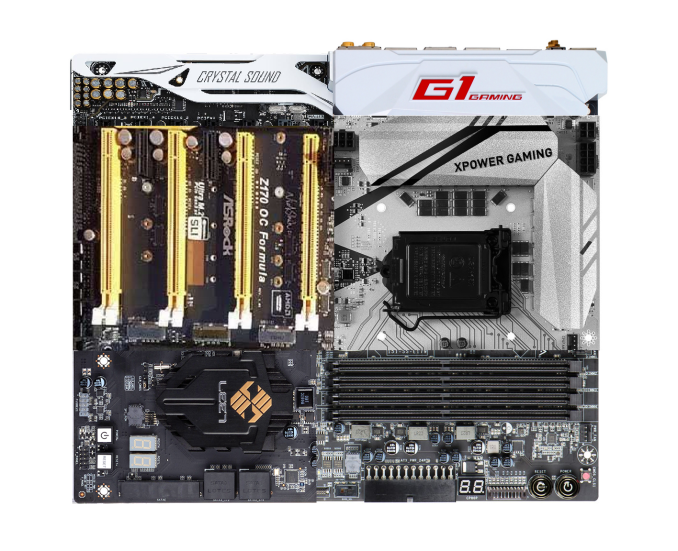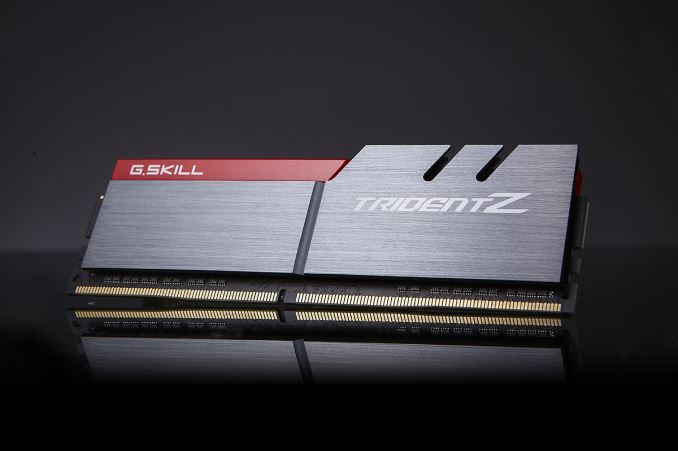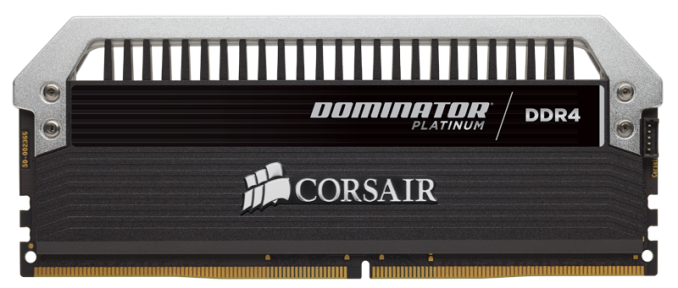The Intel 6th Gen Skylake Review: Core i7-6700K and i5-6600K Tested
by Ian Cutress on August 5, 2015 8:00 AM ESTAlso Launching Today: Z170 Motherboards, Dual Channel DDR4 Kits
The new Skylake processors are assigned a new socket – LGA1151. Intel’s policy since 2006 has been to maintain sockets for two generations and as a result moving from Broadwell to Skylake we were expecting the change. This means that Skylake processors will not work in LGA1150 based motherboards, i.e. those with Intel’s 8th and 9th generation chipsets. For Skylake we get the 100-series chipsets with additional functionality. Launching today in turn is the first member of the 100-series family, the overclocking-friendly Z170, with the other chipsets in the family to follow later in the year.
We have a large piece on the motherboards being released or talked about for Skylake, covering some 55+ products and the different variations within. The major motherboard manufacturers such as ASUS, GIGABYTE, ASRock, MSI, EVGA and a couple of others should all have a wide range ready to purchase on day one, although some models may be region specific.

The badly MSPaint’ed hybrid: MSI’s XPower Gaming Socket, GIGABYTE’s G1 Gaming IO panel, EVGA’s DRAM slots, ECS’s chipset, ASRock’s PCIe arrangement and ASUS’ Deluxe audio.
Here’s an amalgamation of some of the designs coming to end users, with almost all of them investing heavily in gaming brands with specific components to aid the user experience while gaming. Aesthetic designs are also going to be a focus of this generation, with some of the manufacturers moving into a different direction with their designs and trying some new color schemes. Some basic looking models will also be available.
Prices for Z170 motherboards will range from $80 all the way past $400+, depending on feature set and size. A number of motherboards above $150 will feature a couple USB 3.1 Gen 2 (10Gbps) ports, although you will have to check whether they are Type-A or Type-C. That being said, most motherboards with USB 3.1 will use both, but there are a select few that are C-only or A-only. Also over $150 we will see a lot of Intel’s new network controller, the I219-V, although the gaming lines might invest in Rivet Network’s Killer solution instead.
Intel is launching the Alpine Ridge controller at this time as well, which is said to support USB 3.1 Gen 2, Thunderbolt 3, HDMI 2.0, DisplayPort, and DockPort. According to our sources it would seem that GIGABYTE currently has an exclusive on this technology, and it will be used for their USB 3.1 Gen 2 ports on most motherboard models. Other functionality from the Alpine Ridge controller (TB3, HDMI 2.0) will be on a case-by-case basis depending on how the controller works in two different modes or if extra components are used. We are told that Alpine Ridge costs similarly to the ASMedia ASM1142 controller, but will enable two USB 3.1 Gen 2 ports at 10 Gbps simultaneously as it uses four PCIe lanes from the chipset.
We will go more into the 100-series chipset in the next page, but it is worth mentioning briefly here that the speed between the CPU and the chipset has increased from DMI 2.0 (5 GT/s, 2GB/sec) to DMI 3.0 (8 GT/s, 3.93GB/sec), and that the chipset has a new high speed hub (HSIO) that allows 26 lanes to be used from it although some lanes are limited (e.g. 20 PCIe 3.0 lanes maximum split into five x4 controllers). Intel’s Rapid Storage Technology is upgraded as well to give three PCIe drives access to its features as long as they are on the correct HSIO ports.
DRAM: The March to DDR4
In the world of DRAM for personal computers, DDR3 is currently king. Having been the main standard since 2007, you would be hard pressed to find a mainstream or low end platform sold that did not require access to DDR3. That changed in the enthusiast segment last year with the launch of Haswell-E which also introduced DDR4 at a high premium. For Haswell-E there was no crossover – you had no choice but to use DDR4 (unless you might be a million-unit customer).
Because the consumers and consumer product OEMs are more price sensitive, DDR4 will be a slower transition. There is precedent here in that the move from DDR2 to DDR3 saw a generation of processors that supported both standards and it was up to the motherboard manufacturer to design for it. In this transition, Skylake processors will support both DDR3L and DDR4 modules, with a few caveats.
Caveat number one is that initially, only DDR4 motherboards will be on the market. So if you upgrade now, DDR4 needs to be on the shopping list as well. We have had word of some DDR3L-only motherboards coming, as well as combo boards with DDR3L and DDR4 slots on board. Caveat one-point-five, you can use either DDR3L or DDR4, but not both at the same time.
Caveat number two, DDR3L is different to DDR3 as it operates at a lower voltage. This means that the memory controllers on Skylake most likely have a combined voltage domain, and regular DDR3 might not work (in fact early testing suggests not without reducing the voltage). Very few people currently own DDR3L DIMMs, so the likelihood of a user performing an upgrade while reusing their RAM might be slim.
Caveat number three: prices of DDR4 have dropped significantly since last year, and there is only a small premium over DDR3. The benefits of DDR4 include a lower operating voltage, a more stable design, and the ability to purchase 16GB modules with ease. That means that a Skylake platform will happily take 64GB of memory.
With that last point, we should point out that Skylake is a dual memory channel architecture, supporting two memory modules per channel. This gives a maximum of four DDR4 tests, and 4x16 = 64GB maximum.
We have been told that Skylake’s memory controller, compared to previous generations, is absolutely golden at higher speed memory support. By default Skylake supports the JEDEC standard for DDR4, 2133 MT/s at a latency of 15-15-15, but the overclocking guides we have received suggests that all processors should be able to reach DDR4-3200 relatively comfortably, with a few processors in the right motherboards going for DDR4-4000. While this should bode well for integrated graphics users, those high end kits are typically very expensive.
We currently have dual channel kits in to test from a number of the DRAM companies, and plan on performing a memory scaling article within the next few weeks to see how exactly performance might scale on Skylake. Though in the meantime, as part of this review, we were able to source a closed beta variant of a combination DDR3L/DDR4 motherboard for Skylake and have included a test comparing the two.












477 Comments
View All Comments
xxxGODxxx - Saturday, October 31, 2015 - link
Hi guys I would like to know whether I should buy the 6600k with a z170 mobo at $417 or should I buy a 3930k with a x79 mobo at $330? I'm not too sure if the extra IPC of the 6600k is enough to warrant the extra $87 over the 3930k especially since I will be overclocking the cpu and I will be gaming on a r9 390 (maybe I will add one more 390 in the future) at 1440p.Toyevo - Wednesday, November 25, 2015 - link
Even now I hesitate at updating a Phenom II X4 945. The Samsung 950 Pro pushed me over the line, and with it the need for PCIe M.2 only available in recent generations. There's no holy grail in CPUs, only what's relevant for each individual today. Of several other systems I have, none demand any change yet. On the Intel side my 2500K (and up) I wouldn't bother with even Skylake. With AMD my FX6300 (and up) are more power hungry but entirely adequate. And our E5-2xxx servers sit on Ivy Bridge until early 2017.What does all this mean? Not a lot.. In the same way many of you see Skylake as a non event, I equally saw Broadwell and Haswell as non events. 20 years ago the jumps were staggering, overclocking wasn't nearly as trendy, nor as straight forward, but entirely necessary, the cost of new hardware prohibitively expensive. The generations were so definitive and fast back then.
i_will_eat_you - Saturday, December 12, 2015 - link
This is a good review, especially the look at memory latency. The 4690K is left out however from a lot of benchmarks. If you include that then I don't see much of an attraction to skylake. There is also the concern about the new rootkit support skylake introduces with protected code execution. This is not something I see being used for the good of the consumer.My one gripe is the lack of benchmarks for intense game engines (simulations, etc). Total war is there which is a step forward but I'm not sure if that benchmark really measures simulation engine performance.
If you take games such as Sins of a Solar Empire or Supreme Commander then they have a separate thread for graphics so tend to maintain a decent frame rate even when the game engine runs at a crawl. The more units you add to the map and the more that is going on the slower it goes. But this is not in FPS. It means that ordering a ship across the solar system might take 10 s when there are 1000 units in the game but 5 minutes when there are 100000 units in the game. I would love to see some benchmarks measuring engine performance of games such as this with the unit limits greatly increased. It is a bit of a niche but many sim games (RTS, etc) scale naturally which means you can increase the unit limit, map size, AI difficulty, number of AIs, etc as your hardware becomes more powerful.
This is especially relevant with CPUs such as the broadwell which might gain a big advantage each game loop processing the very large simulation engine dataset.
systemBuilder - Tuesday, July 19, 2016 - link
Wow your review really sucked. Where are the benchmarks for the i5-6600k? Did you forget?POPCORNS - Friday, August 19, 2016 - link
To me, It doesn't matter if there's no IPC improvement over Sandy Bridge, Ivy Bridge or Haswell,Because I've upgraded from a Wolfdale Celeron (E3300) to a Skylake (6700K), lol.
oranos - Thursday, December 29, 2016 - link
This article seems to be confused. DDR4 brings more sustained framerates for higher resolutions (especially 4k). Really a waste of time doing a 1080p comparison.oranos - Thursday, December 29, 2016 - link
if you wanted to do a proper test for DDR4 gaming performance you should run a 6700K and GTX 1080 minimum and run multiple games in 4K for testing.